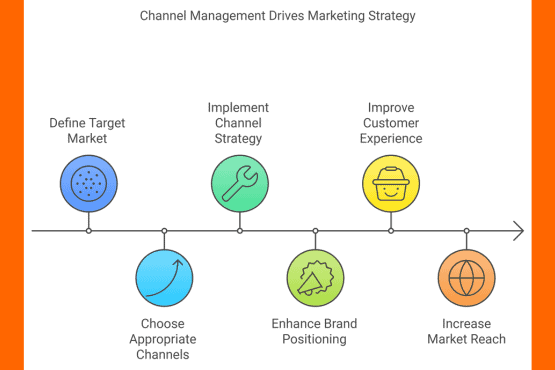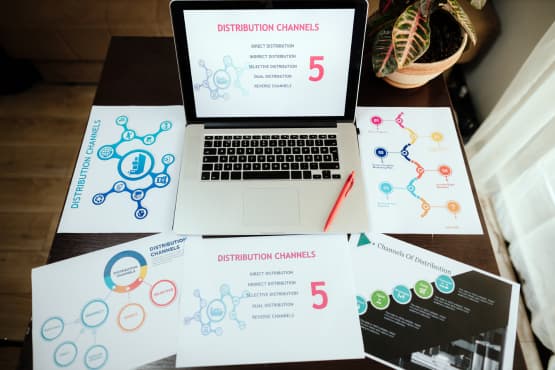You have a great product, but it just sits in your warehouse collecting dust and doesn’t reach the people who would benefit from having it. It can be a common occurrence for companies that do not consider better channel management when planning their comprehensive strategy.
Channel management is the skill and knowledge of getting your products or services to customers smoothly and reasonably. It’s about making a clear path from making to buying, ensuring your stuff is there when and where your customers want it.
We aim to provide you with the knowledge and tools to create a powerful channel management plan that increases sales and improves customer satisfaction. This guide presents helpful tips to support your success, whether you’re launching a new venture or a seasoned expert looking to hone your abilities.
Key Components of Channel Management
Types of Distribution Channels
Distribution channels are the routes your products take to get to end consumers.

Let’s look at the main types:
- Direct Channels: This impacts selling straight to buyers, often through stores the company owns or online shops. Apple, for instance, sells its products through its shops and website.
- Indirect Channels: These have intermediaries like wholesalers or retailers. A common example is how most everyday items reach customers through grocery stores.
- Multi-level Channels: These include several middlemen before reaching the final buyer. Car makers often use this model to sell to distributors, who then sell to car dealers.
- Hybrid Channels: This method mixes direct and indirect ways. Dell Computers is known to use this approach to sell directly to consumers and retail partners.
Each type has its pros and cons. Direct channels give you more control but need a big investment. Indirect channels can help you reach more people quickly but might cut your profits.
The trick is to pick the right mix that fits your business goals and the customers you want to reach.
The Role of Channel Partners
Channel partners play a crucial role in getting your products to market. Here are the main types:
- Distributors are the middlemen who buy in bulk and sell to retailers or other businesses. They often provide storage, logistics, and sometimes marketing support.
- Retailers: These are the businesses that sell directly to consumers. They can range from small local shops to large chain stores or e-commerce platforms.
- Agents: These representatives promote and sell your products but don’t take ownership of them. They’re common in industries like insurance or real estate.
Each partner type contributes uniquely to your distribution strategy. For instance, distributors can help you reach a wider geographic area, while retailers provide the crucial last step in the customer’s buying journey.
Channel Management Tools
These days managing channels depends a lot on tech. Here are some essential tools:
- Customer Relationship Management (CRM) Systems: These systems track interactions with customers and channel partners. They provide valuable insights to make decisions.
- Enterprise Resource Planning (ERP) Software combines various business processes. It includes inventory management and order processing. These are key to running channel operations well.
- Supply Chain Management Tools: These tools help improve the flow of goods from production to delivery. They make sure products are ready when and where people need them.
- Marketing Automation Platforms: These platforms help to organize marketing work across different channels. They make sure the message and brand experience stays the same everywhere.
Using the right mix of these tools can boost your channel management work. This leads to better efficiency and stronger relationships with partners.
Link Between Channel Management and Marketing Strategy
Channel management goes beyond logistics—it is crucial to your overall marketing strategy. Your choice of channels and how you handle them can significantly impact your brand positioning, customer experience, and market reach.
Take luxury brands, for example. They often pick exclusive distribution channels to keep their high-end image. In contrast, companies selling fast-moving consumer goods go for wide distribution to boost visibility and make things easy for customers.

Your channel strategy should match how your target market likes to shop and buy. If your audience prefers to shop online, you’ll want to focus on e-commerce channels.
On the flip side, building a strong network of physical retail partners might work better if your products need to be shown in person.
Remember, your channels are often where your brand and customers meet. Ensuring customers have a good experience across all channels helps build strong relationships and brand loyalty.
Effective Management Practices
Setting Clear Goals and Objectives
Successful channel management starts with clear, measurable goals. These should align with your overall business objectives and follow the SMART criteria:
- Specific
- Measurable
- Achievable
- Relevant
- Time-bound
For example, instead of a vague goal like “increase sales,” you might aim to “increase sales through our distributor network by 15% in the next fiscal year.”
Training and Supporting Channel Partners
Your channel partners are extensions of your team. Investing in their success is investing in your own. This includes:
- Providing comprehensive product training
- Offering marketing and sales support materials
- Ensuring clear communication channels for queries and feedback
- Recognizing and rewarding high-performing partners
Cisco Systems is known for its excellent partner training programs, contributing significantly to its success in the
Monitoring and Evaluating Performance
Regular performance evaluation is crucial for effective channel management. Key Performance Indicators (KPIs) might include:
- Sales volume
- Market share
- Customer satisfaction scores
- Inventory turnover rates
Use data-driven insights to make informed decisions about your channel strategy. This might involve reallocating resources to high-performing channels or addressing issues in underperforming ones.
Overcoming Common Hurdles

New channel managers often run into several problems:
- Channel Conflict: This happens when different channels try to sell to the same customers. Picture a manufacturer who begins to sell straight to buyers – this might upset their store partners. To fix this problem, you need to talk and give each channel a specific job.
- Inventory Management: Keeping the right stock across different channels is challenging. Too much stock means your money is tied up, but having too little means losing sales. You should use good stock tracking systems and keep talking with your partners to solve this.
- Performance Measurement: When you have many channels and partners, tracking how well things are going is tricky. To handle this, you must invest in good tools to analyze data and set up clear ways to report results.
- Building Relationships: It takes time and effort to build strong relationships with partners based on trust. To help create these bonds, you should talk often, be open, and set goals together.
Nurturing Strong Partner Relationships
Strong relationships with channel partners are the backbone of successful channel management. Here are some tips:
- Effective Communication: Establish regular check-ins and clear channels for feedback. Be transparent about your goals and expectations.
- Mutual Trust: Follow through on your commitments and be fair. Trust is built over time through consistent actions.
- Collaboration: Involve partners in strategy discussions. Their on-the-ground insights can be invaluable.
- Fair Contracts: Ensure your agreements are transparent and mutually beneficial. Address potential issues upfront to avoid future conflicts.
- Ongoing Support: Provide the resources and support your partners need to succeed. This could include training, marketing materials, or technical support.
Success Stories in Action
Let’s look at some real-world examples of effective channel management:
- Coca-Cola: Known for its extensive distribution network, Coca-Cola ensures its products are available “within an arm’s reach of desire.” Their success lies in strong relationships with bottlers and retailers worldwide and a deep understanding of local markets.
- Amazon: While primarily known for direct sales, Amazon has successfully integrated third-party sellers into its platform. This has dramatically increased product variety without the need for Amazon to manage all inventory directly.
- Microsoft: Their partner network is a cornerstone of their business model. Microsoft has built a global partner network that extends its reach and capabilities by providing extensive training, support, and incentives.
These companies demonstrate how effective channel management can drive growth, increase market share, and enhance customer satisfaction.
The Future of Channel Management
The world of channel management is evolving rapidly. Here are some trends to watch:

- Omnichannel Retailing: Customers expect seamless experiences across all channels. Integrating online and offline channels will be crucial.
- E-commerce Growth: The continued rise of e-commerce is reshaping distribution strategies. Even traditional B2B companies are exploring direct-to-consumer models.
- Artificial Intelligence: AI and machine learning optimize inventory management, predict demand, and personalize customer experiences across channels.
- Sustainability: There’s growing pressure to create more sustainable supply chains. This could impact channel choices and partner selection criteria.
- Data-Driven Decision-Making: Advanced analytics will play an increasingly important role in channel strategy and performance evaluation.
These trends present both challenges and opportunities. Staying informed and adaptable will be key to future success in channel management.
Conclusion
Effective channel management is a helpful tool for growing a business and keeping customers happy. By understanding the key parts, matching your channel plan with your overall marketing goals, and building strong partner relationships, you can create a distribution network that gives you an edge over the competition.
Remember, no one channel strategy works for every business. Your plan should fit your specific products, target market, and business goals. Always learning, adapting, and improving are key to long-lasting success.
As you start your channel management journey, keep these main takeaways in mind:
- Pick the right mix of channels for your business
- Invest in good relationships with your channel partners
- Use technology to increase efficiency and get insights
- Match your channel plan to your overall marketing goals
- Be ready to evolve as the market changes
By mastering the basics of channel management, you’re setting up your business for sustainable growth and success. Keep learning, stay curious, and don’t be afraid to innovate how you reach and serve your customers.




